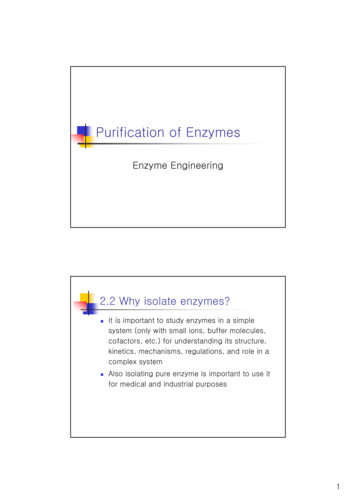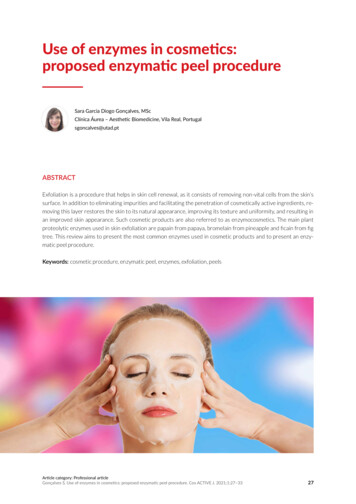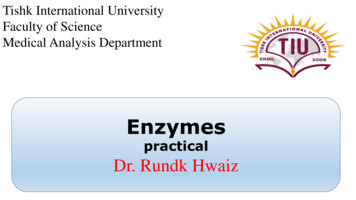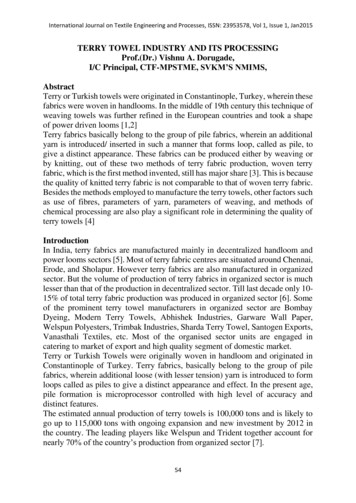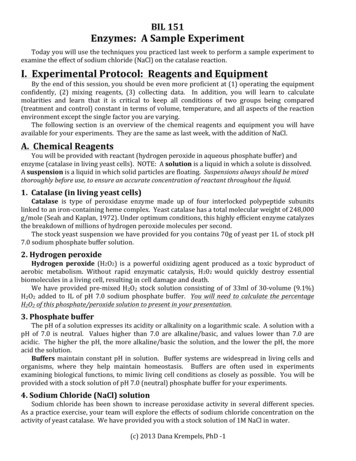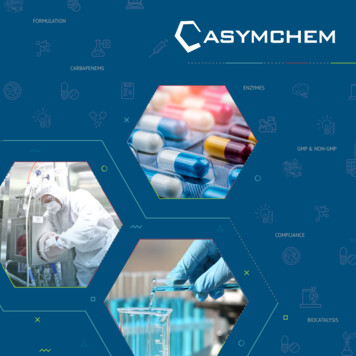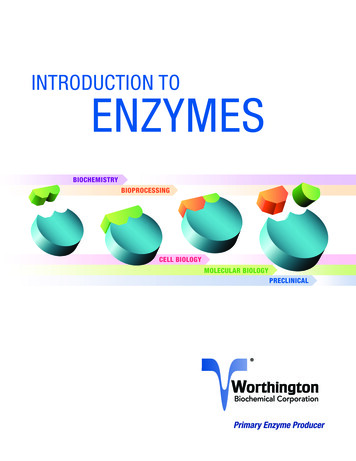
Transcription
INTRODUCTION TOENZYMESBIOCHEMISTRYBIOPROCESSINGCELL BIOLOGYMOLECULAR BIOLOGYPRECLINICAL
INTRODUCTION TOENZYMESContributing Authors/Editors:Charles C. WorthingtonVon WorthingtonAndrew Worthington, Ph.D.The use of enzymes in the diagnosis of disease is one of theimportant benefits derived from the intensive research inbiochemistry since the 1940s. Enzymes have provided the basisfor the field of clinical chemistry.Given the dramatic growth of life science research over recentdecades, interest in diagnostic enzymology has multiplied. NewAI online tools aid researchers in the area of medical researchin which the diagnostic potential of enzyme reactions can befound.Prepared by Worthington Biochemical Corporation, this overviewis a practical introduction to enzymology. As a result of closeinvolvement over the years in the theoretical as well as the practicalaspects of enzymology, Worthington’s knowledge covers a broadspectrum of the subject. This information has been assembledhere for the benefit of a new generation of researchers.2INTRODUCTION TO ENZYMESWorthington-Biochem.com
Enzymes and Life ProcessesThe living cell is the site of tremendous biochemical activity called metabolism. Thisis the process of chemical and physical change which goes on continually in theliving organism. These changes include the build-up of new tissue, replacement ofold tissue, conversion of food to energy, disposal of waste materials, reproduction,etc. – all the activities that we characterize as “life.”This building up and tearing down takes place in the face of an apparent paradox. Thegreatest majority of these biochemical reactions do not take place spontaneously. Thephenomenon of catalysis makes possible biochemical reactions necessary for all lifeprocesses. Catalysis is defined as the acceleration of a chemical reaction by somesubstance which itself undergoes no permanent chemical change. The catalysts ofbiochemical reactions are enzymes and are responsible for bringing about almost allof the chemical reactions in living organisms. Without enzymes, these reactions takeplace at a rate far too slow for the pace of metabolism.The oxidation of a fatty acid to carbon dioxide and water is not a gentle processin a test tube – extremes of pH, high temperatures and corrosive chemicals arerequired. Yet in the body, such a reaction takes place smoothly and rapidly within anarrow range of pH and temperature. In the laboratory, the average protein must beboiled for about 24 hours in a 20% HCl solution to achieve a complete breakdown.In the body, the breakdown takes place in four hours or less under conditions of mildphysiological temperature and pH.It is through attempts at understanding more about enzyme catalysts – what theyare, what they do, and how they do it – that many advances in medicine and the lifesciences have been brought about.Early Enzyme DiscoveriesThe existence of enzymes has been known for well over a century. Some of theearliest studies were performed in 1835 by the Swedish chemist, Jon Jakob Berzeliuswho termed their chemical action catalytic. It was not until 1926, however, that thefirst enzyme was obtained in pure form, a feat accomplished by James B. Sumnerof Cornell University. Sumner was able to isolate and crystallize the enzyme ureasefrom the jack bean. His work was to earn him the 1947 Nobel Prize.John H. Northrop and Wendell M. Stanley of the Rockefeller Institute for MedicalResearch shared the 1947 Nobel Prize with Sumner. They discovered a complexprocedure for isolating and purifying pepsin. This precipitation technique devised byNorthrop and Stanley has been used to crystallize several enzymes.3INTRODUCTION TO ENZYMESWorthington Biochemical Corporation800.445.9603
Chemical Nature of EnzymesMost enzymes are proteins, although a few are catalytic RNA molecules. CatalyticRNA molecules are called ribozymes. Enzymes are high molecular weight compoundsmade up principally of chains of amino acids linked together by peptide bonds(Figure 1). Enzymes can be denatured and precipitated with salts, solvents and otherreagents. They have molecular weights ranging from 10,000 to 2,000,000 Da.Peptide BondHHHH andrepresent twowhere R’––NHCR – C – C0 – NH – C – R’R – C – NH2 typical amino acids2 COOHNH2COOHCOOHFigure 1: Typicalprotein structure – twoamino acids joined by apeptide bond.Many enzymes require the presence of other compounds – cofactors – beforetheir catalytic activity can be exerted. This entire active complex is referred to asthe holoenzyme; i.e., apoenzyme (protein portion) plus the cofactor(s) (coenzyme,prosthetic group or metal-ion activator) (Figure 2).Figure 2: Holoenzymesplus various types ofcofactors.ApoenzymeApoenzymeCoenzymeProsthetic GroupApoenzymeMetal IonAccording to Holum, the cofactor may be:1. A coenzyme – a non-protein organic substance which is dialyzable, thermostableand loosely attached to the protein part.2. A prosthetic group – an organic substance which is dialyzable and thermostablewhich is firmly attached to the protein or apoenzyme portion.3. A metal-ion-activator – these include K , Fe2 , Fe3 , Cu2 , Co2 , Zn2 , Mn2 ,Mg2 , Ca2 , and Mo3 .4INTRODUCTION TO ENZYMESWorthington-Biochem.com
Specificity of EnzymesOne of the properties of enzymes that makes them so important as diagnostic andresearch tools is the specificity they exhibit relative to the reactions they catalyze. Afew enzymes exhibit absolute specificity; that is, they will catalyze only one particularreaction. Other enzymes will be specific for a particular type of chemical bond orfunctional group.In general, there are four distinct types of specificity:1. Absolute specificity – the enzyme will catalyze only one reaction.2. Group specificity – the enzyme will act only on molecules that have specificfunctional groups, such as amino, phosphate and methyl groups.3. Linkage specificity – the enzyme will act on a particular type of chemical bondregardless of the rest of the molecular structure.4. Stereochemical specificity – the enzyme will act on a particular steric oroptical isomer.Though enzymes exhibit great degrees of specificity, cofactors may serve manyapoenzymes. For example, nicotinamide adenine dinucleotide (NAD) is a coenzymefor a great number of dehydrogenase reactions in which it acts as a hydrogenacceptor. Among them are the alcohol dehydrogenase, malate dehydrogenase andlactate dehydrogenase reactions.Naming and ClassificationExcept for some of the originally studied enzymes such as pepsin, rennin, and trypsin,most enzyme names end in “ase”. The International Union of Biochemistry (I.U.B.)initiated standards of enzyme nomenclature which recommended that enzyme namesindicate both the substrate acted upon and the type of reaction catalyzed. Under thissystem, the enzyme uricase is called urate: O2 oxidoreductase, while the enzymeglutamic oxaloacetic transaminase (GOT) is called L-aspartate: 2-oxoglutarateaminotransferase.The I.U.B. devised a system of classification and identification of enzymes in termsof the reactions they catalyse. This relies on a numerical system (the EC number) toclassify enzymes in groups according to the types of reaction catalysed and systematicnaming that describes the chemical reaction involved. This is now in widespreaduse, and the official list of enzymes classified can be found at ExplorEnz – TheEnzyme Database ( http://www.enzyme-database.org). The enzyme nomenclature isincorporated into many other resources, including the ExPASy-ENZYME, BRENDA andKEGG bioinformatics databases.The EC number or Enzyme Commision number is a four-component identifierwhich classifies an enzyme according to class, subclass, sub-subclass and the finalcompontent being a serial number within that sub-subclass. The EC classes arecurrently listed as:1. Oxidoreductases – To this class belong all enzymes catalysing oxidationreduction reactions. The substrate that is oxidized is regarded as hydrogen donor.2. Transferases – Transferases are enzymes transferring a group, e.g. a methylgroup or a glycosyl group, from one compound (generally regarded as donor) toanother compound (generally regarded as acceptor).5INTRODUCTION TO ENZYMESWorthington Biochemical Corporation800.445.9603
3. Hydrolases – These enzymes catalyse the hydrolytic cleavage of C-O, C-N,C-C and some other bonds, including phosphoric anhydride bonds.4. Lyases – Lyases are enzymes cleaving C-C, C-O, C-N, and other bonds byelimination, leaving double bonds or rings, or conversely adding groups todouble bonds.5. Isomerases – These enzymes catalyse geometric or structural changeswithin one molecule. According to the type of isomerism, they may be calledracemases, epimerases, cis-trans-isomerases, isomerases, tautomerases,mutases or cycloisomerases.6. Ligases – Ligases are enzymes catalysing the joining together of two moleculescoupled with the hydrolysis of a diphosphate bond in ATP or a similar triphosphate7. Translocases – Catalysing the translocation of hydrogen ions, inorganic cationsand anions, amino acids, carbohydrates or other compounds. A new EC classwas created in 2018.Basic Enzyme ReactionsEnzymes are catalysts that increase the the speed of a chemical reaction withoutthemselves undergoing any permanent chemical change. They are neither used upin the reaction nor do they appear as reaction products.The basic enzymatic reaction can be represented as follows:S E P EE represents the enzyme catalyzing the reaction; S, the substrate, the substance being modified;and P, the product of the reaction.The Enzyme Substrate ComplexA theory to explain the catalytic action of enzymes was proposed by the Swedishchemist Savante Arrhenius in 1888. He proposed that the substrate and enzymeformed some intermediate substance which is known as the enzyme/substratecomplex (ES). The reaction can be represented as:S E ESS Substrate; E Enzyme; ES Enzyme/Substrate ComplexIf this reaction is combined with the original reaction equation, the following results:S E ES P ES Substrate; E Enzyme; ES Enzyme/Substrate Complex; P ProductThe existence of an intermediate enzyme-substrate complex has been demonstratedin the laboratory, for example, using catalase and a hydrogen peroxide derivative.At Yale University, Kurt G. Stern observed spectral shifts in catalase as the reactionit catalyzed proceeded. This experimental evidence indicates that the enzyme firstbinds with the substrate and then returns to its original form after the reaction isconcluded.6INTRODUCTION TO ENZYMESWorthington-Biochem.com
Chemical EquilibriumThe study of a large number of chemical reactions reveals that most do not go to truecompletion. This is likewise true of enzymatically-catalyzed reactions. This is due tothe reversibility of most reactions.In general:K 1A B C D (Forward Reaction)K-1C D A B (Revese Reaction)K 1 is the forward reaction rate constant and K-1 is the rate constant for the reverse reaction.Combining the two reactions gives:K 1 C DA B K-1Applying this general relationship to enzymatic reactions allows the equation:K 2K 1 P E E S ES K-1K-2Equilibrium, a steady state condition, is reached when the forward reaction ratesequal the backward rates. This is the basic equation upon which most enzymeactivity studies are based.Energy LevelsChemists have known for almost a century that for most chemical reactions toproceed, some form of energy is needed. They have termed this quantity of energy,“the energy of activation.” It is the magnitude of the activation energy whichdetermines just how fast the reaction will proceed. It is believed that enzymes lowerthe activation energy for the reaction they are catalyzing (Figure 3). The enzyme isthought to reduce the “path” of the reaction. This shortened path would require lessFigure 3: Energy ofactivation ΔEa is lessthan ΔEa’ due to theeffect of the enzyme onthe substrate.ΔEa (E1 - E0)E1Energy LevelΔEa’ (E2 - E0)E2No EnzymeWith EnzymeE0Reactant Energy LevelProduct Energy LevelE7Reaction ProcessINTRODUCTION TO ENZYMESWorthington Biochemical Corporation800.445.9603
energy for each molecule of substrate converted to product. Given a total amount ofavailable energy, more molecules of substrate would be converted when the enzymeis present (the shortened “path”) than when it is absent. Hence, the reaction is saidto go faster in a given period of time.Factors Affecting Enzyme ActivityKnowledge of basic enzyme kinetic theory is important for enzyme analysis in orderto both understand the basic enzymatic mechanism and select a method for enzymeanalysis. The conditions selected to measure the activity of an enzyme would not bethe same as those selected to measure the concentration of its substrate. Severalfactors affect the rate at which enzymatic reactions proceed – enzyme concentration,substrate concentration, the presence of any inhibitors or activators, temperature,and pH.Enzyme ConcentrationIn order to study the effect of increasing the enzyme concentration upon thereaction rate, the substrate must be present in an excess amount; i.e., the reactionmust be independent of the substrate concentration. Any change in the amount ofproduct formed over a specified period of time will be dependent upon the levelof enzyme present. Graphically this can be represented as indicated in Figure 4.These reactions are said to be “zero order” because the rates are independentof substrate concentration, and are equal to some constant k. The formation ofproduct proceeds at a rate which is linear with time. The addition of more substratedoes not serve to increase the rate. In zero order kinetics, allowing the assay to runfor double time results in double the amount of product (Table 1).Product ConcentrationWith 2x EnzymeFigure 4: “Zero order” reaction rate isindependent of substrate concentration.With 1x EnzymeNo EnzymeTimeTable 1: Reaction orders with respect to substrate concentration.OrderZeroFirstSecondSecond8Rate Equationrate krate k[S]rate k[S][S] k[S]2rate k[S1][S2]INTRODUCTION TO ENZYMESCommentsrate is independent of substrate concentrationrate is proportional to the first power of substrate concentrationrate is proportional to the square of the substrate concentrationrate is proportional to the first power of each of two reactantsWorthington-Biochem.com
The amount of enzyme present in a reaction is measured by the activity it catalyzes.The relationship between activity and concentration is affected by many factorssuch as temperature, pH, etc. An enzyme assay must be designed so that theobserved activity is proportional to the amount of enzyme present in order thatthe enzyme concentration is the only limiting factor. It is satisfied only when thereaction is zero order.In Figure 5, activity is directly proportional to concentration in the area AB, but notin BC. Enzyme activity is generally greatest when substrate concentration is notlimiting.Observed ActivityFigure 5: Activity vs.concentration.ABEnzyme ConcentrationCWhen the concentration of the product of an enzymatic reaction is plotted againsttime, a similar curve results (Figure 6). Between A and B, the curve represents azero order reaction; that is, one in which the rate is constant with time. A substrate isused up, the enzyme’s active sites are no longer saturated, substrate concentrationbecomes rate limiting, and the reaction becomes first order between B and C.Product ConcentrationFigure 6: Reaction ratelimited by substrateconcentration.ABCTime9INTRODUCTION TO ENZYMESWorthington Biochemical Corporation800.445.9603
To measure enzyme activity ideally, the measurements must be made in thatportion of the curve where the reaction is zero order. A reaction is most likely tobe zero order initially since substrate concentration is then highest. To be certainthat a reaction is zero order, multiple measurements of product (or substrate)concentration must be made.Figure 7 illustrates three types of reactions which might be encountered inenzyme assays and shows the problems which might be encountered if onlysingle measurements are made.Product ConcentrationFigure 7: Leading,lagging, and linearreaction.AEBCTimeB is a straight line representing a zero order reaction which permits accuratedetermination of enzyme activity for part or all of the reaction time. A represents thetype of reaction that was shown in Figure 6. This reaction is zero order initially andthen slows, presumably due to substrate exhaustion or product inhibition. This typeof reaction is sometimes referred to as a “leading” reaction. True “potential” activityis represented by the dotted line. Curve C represents a reaction with an initial “lag”phase. Again the dotted line represents the potentially measurable activity. Multipledeterminations of product concentration enable each curve to be plotted and trueactivity determined. A single end point determination at E would lead to the falseconclusion that all three samples had identical enzyme concentration.10INTRODUCTION TO ENZYMESWorthington-Biochem.com
Substrate ConcentrationIt has been shown experimentally that if the amount of the enzyme is keptconstant and the substrate concentration is then gradually increased, the reactionvelocity will increase until it reaches a maximum. After this point, increases insubstrate concentration will not increase the velocity (Δ Absorbance/Δ Time). This isrepresented graphically in Figure 8.Figure 8: Effect ofsubstrate concetration.Reaction VelocityEVmax1/2 VmaxK m [S]1/2 Vmax[S] - Substrate ConcentrationIt is theorized that when this maximum velocity had been reached, all of the availableenzyme has been converted to ES, the enzyme/substrate complex. This point on thegraph is designated Vmax. Using this maximum velocity and equation, Michaelisdeveloped a set of mathematical expressions to calculate enzyme activity in termsof reaction speed from measurable laboratory data.K 1K 2 E S ES P EK-1K-2Km K-1 K2K 1 SVmaxvt Vmax [S]Km [S]vt the velocity at any time[S] the substrate concentration at this timeVmax the highest velocity under this set of experimental conditions (pH, temperature)Km the Michaelis constant for the particular enzyme being investigatedMichaelis constants have been determined for many of the commonly usedenzymes. The size of Km tells us several things about a particular enzyme.1. A small Km indicates that the enzyme requires only a small amount ofsubstrate to become saturated. Hence, the maximum velocity is reached atrelatively low substrate concentrations.2. A large Km indicates the need for high substrate concentrations to achievemaximum reaction velocity.3. The substrate with the lowest Km upon which the enzyme acts as a catalyst isfrequently assumed to be enzyme’s natural substrate, though this is not truefor all enzymes.11INTRODUCTION TO ENZYMESWorthington Biochemical Corporation800.445.9603
Effects of Inhibitors on Enzyme ActivityEnzyme inhibitors are substances which alter the catalytic action of the enzymeand consequently slow down, or in some cases, stop catalysis. There are threecommon types of enzyme inhibition – competitive, non-competitive and substrateinhibition.Most theories concerning inhibition mechanisms are based on the existence of theenzyme-substrate complex ES. As mentioned earlier, the existence of temporary ESstructures has been verified in the laboratory.Competitive inhibition occurs when the substrate and a substance resembling thesubstrate are both added to the enzyme. A theory called the “lock-and-key theory”of enzyme catalysts can be used to explain why inhibition occurs (Figure 9).3 Lock/Key ScenariosKey fits lock – turns it – thus opening the doorfor reaction to proceed.LegendFigure 9: Lock and keytheory – competitiveanalysis.EnzymeSubstrateKey fits lock, but lock will not turn.Reaction is slowed because enzyme is occupied.Substance Similar to SubstrateEnzyme rejects dissimilar substance andaccepts substrate – reaction proceeds.Dissimilar SubstanceThe lock and key theory utilizes the concept of an “active site.” The concept holdsthat one particular portion of the enzyme surface has a strong affinity for thesubstrate. The substrate is held in such a way that its conversion to the reactionproducts is more favorable. We consider the enzyme as the lock and the substratethe key – the key is inserted in the lock, the key is turned, and the door is opened(the reaction proceeds) (Figure 9). However, when an inhibitor which resemblesthe substrate is present, it will compete with the substrate for the position in theenzyme lock. When the inhibitor wins, it gains the lock position but is unable toopen the lock. Hence, the observed reaction is slowed down because some of theavailable enzyme sites are occupied by the inhibitor. If a dissimilar substance thatdoes not fit the site is present, the enzyme rejects it, accepts the substrate instead,and the reaction proceeds normally.12INTRODUCTION TO ENZYMESWorthington-Biochem.com
Non-competitive inhibitors are considered to be substances which when added tothe enzyme alter the enzyme in a way that it can no longer accept the substrate(Figure 10). Substrate inhibition will sometimes occur when excessive amounts ofsubstrate are present.Enzyme/Inhibitor BasicsFigure 10: Noncompetitive inhibition.LegendEnzymeEnzyme and SubstrateSubstrateEnzyme and Inhibitor – enzyme is alteredso that the substrate no longer fits.InhibitorFigure 11 shows the reaction velocity decreasing after the maximum velocity hasbeen reached.Reaction VelocityFigure11: Substratebecoming rateinhibiting.VmaxVelocity drops offwith addition of more substrate[S] - Substrate ConcentrationAdditional amounts of substrate added to the reaction mixture after this point actuallydecrease the reaction rate. This is thought to be due to the fact that there are somany substrate molecules competing for the active sites on the enzyme surfacesthat they block the sites and prevent any other substrate molecules from occupyingthem (Figure 12).This causes the reaction rate to drop since all of the enzyme present is not being used.Figure 12: Substrateinhibition.Excess substrate block site so that theenzyme goes unused and the rate dropes.LegendEnzyme13INTRODUCTION TO ENZYMESSubstrateWorthington Biochemical Corporation800.445.9603
Temperature EffectsLike most chemical reactions, the rate of an enzyme-catalyzed reaction increases asthe temperature is raised. A ten degree Centigrade rise in temperature will increasethe activity of most enzymes by 50 to 100%. Variations in reaction temperature assmall as 1 or 2 degrees may introduce changes of 10 to 20% in the results. In thecase of enzymatic reactions, this is complicated by the fact that many enzymesare adversely affected by high temperatures. As shown in Figure 13, the reactionrate increases with temperature to a maximum level, then abruptly declines withfurther increase of temperature. Because most animal enzymes rapidly becomedenatured at temperatures above 40 C, most enzyme determinations are carriedout somewhat below that temperature.Reaction VelocityOptimum TemperatureIncreasingActivityFigure 13: The effectof temperature on thereaction rate.DenaturingTakes PlaceTemperature [ C]Over a period of time, enzymes will be deactivated at even moderate temperatures.Storage of enzymes at 5 C or below is generally the most suitable. Some enzymeslose their activity when frozen.Effects of pHEnzymes are affected by changes in pH. The most favorable pH value – the pointwhere the enzyme is most active – is known as the optimum pH. This is graphicallyillustrated in Figure 14.Figure 14: The effect ofpH on the reaction rate.Reaction VelocityOptimum pHpH14INTRODUCTION TO ENZYMESWorthington-Biochem.com
Extremely high or low pH values generally result in complete loss of activity formost enzymes. pH is also a factor in the stability of enzymes. As with activity, foreach enzyme there is also a region of pH optimal stability. The optimum pH valuewill vary greatly from one enzyme to another, as Table 2 shows. These physical(temperature) and chemical (pH) parameters must be considered and optimized, inorder for an enzymatic reaction to be accurate and reproducible.Table 2: pH for optimum activity.EnzymeLipase (pancreas)Lipase (stomach)Lipase (castor oil)PepsinTrypsinUreaseInvertaseMaltaseAmylase (pancreas)Amylase (malt)CatalaseOptimum pH8.04.0 – 5.04.71.5 - 1.67.8 - 8.77.04.56.1 - 6.86.7 - 7.04.6 - 5.27.0Concluding Thoughts:Many of the current challenges facing researchers in the lifesciences require an appreciation of the complexities of livingorganisms. These complexities are driven in large part bythe enzymes that work together to make life happen. Manymetabolic disorders, cancers, and hereditary diseases involve anenzyme that is not working properly. In addition, new therapeutictreatments for disease often require a thorough understandingof both the enzymes involved in the disease and the biochemicalenvironment in which these enzymes are functioning. Furthercomplexity can also be introduced when there is an infectionpresent and an additional organism’s enzymes (e.g., bacterialantibiotic resistance mechanisms) need to be considered.Decades after the initial discovery of enzymes, the details of howenzymes work individually and how systems of enzymes performa specific function (e.g., synthesize a complex biochemical)continue to require investigation. Moving forward, as scientistsdevelop new pharmaceutical drugs and unravel the complexitiesof aging and disease, the basics of enzymology will continue tobe invaluable.15INTRODUCTION TO ENZYMESWorthington Biochemical Corporation800.445.9603
ReferencesBennett, T. P., and Frieden, E.: Modern Topics in Biochemistry, pg. 43-45,Macmillan, London (1969).Holum, J.: Elements of General and Biological Chemistry, 2nd ed., 377, Wiley, NY(1968).Martinek, R.: Practical Clinical Enzymology: J. Am. Med. Tech., 31, 162 (1969).Harrow, B., and Mazur, A.: Textbook of Biochemistry, 109, Saunders, Philadelphia(1958).Pfeiffer, J.: Enzymes, the Physics and Chemistry of Life, pg 171-173, Simon andSchuster, NY (1954).Michaelis L, Menten ML. Die Kinetik der Invertinwirkung. Biochemische Zeitschrift.1913;49:333–369.Tipton, K. Translocases (EC 7): A new EC Class. Enzyme Nomenclature News,August 2018.Webb E.C., NC-IUBMB. (1992) Enzyme Nomenclature: Recommendations ofthe Nomenclature Committee of the International Union of Biochemistry andMolecular Biology on the Nomenclature and Classification of Enzymes. AcademicPress, New York, NY.Copyright 2019All rights reserved. No part of this work may be reproduced in any form, except for the quotation of brief passagesin reviews, without prior written permission from Worthington Biochemical Corporation, 730 Vassar Ave, Lakewood,NJ 08701, U.S.A.16INTRODUCTION TO ENZYMESRev 12.19Worthington-Biochem.com
A coenzyme - a non-protein organic substance which is dialyzable, thermostable and loosely attached to the protein part. 2. A prosthetic group - an organic substance which is dialyzable and thermostable which is fi rmly attached to the protein or apoenzyme portion. 3. A metal-ion-activator - these include K , Fe2 , Fe3 , Cu2 , Co 2 , Zn .
